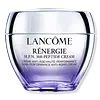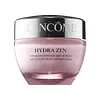What's inside
What's inside
 Key Ingredients
Key Ingredients

 Benefits
Benefits

 Concerns
Concerns

 Ingredients Side-by-side
Ingredients Side-by-side

Water
Skin ConditioningGlycerin
HumectantDimethicone
EmollientCetearyl Alcohol
EmollientTheobroma Grandiflorum Seed Butter
Skin ConditioningAlcohol Denat.
AntimicrobialCetearyl Isononanoate
EmollientNiacinamide
SmoothingGlyceryl Stearate
EmollientPEG-100 Stearate
Isopropyl Palmitate
EmollientOctyldodecanol
EmollientCyclodextrin
AbsorbentHydrolyzed Lupine Protein
Skin ConditioningPisum Sativum Extract
Skin ConditioningAdenosine
Skin ConditioningCapryloyl Salicylic Acid
ExfoliatingHydrolyzed Hyaluronic Acid
HumectantHydrolyzed Linseed Extract
Skin ConditioningPentaerythrityl Tetra-Di-T-Butyl Hydroxyhydrocinnamate
AntioxidantTrisodium Ethylenediamine Disuccinate
Tocopheryl Acetate
AntioxidantCera Alba
EmollientOrbignya Oleifera Seed Oil
EmollientSimmondsia Chinensis Butter
Skin ConditioningCetearyl Glucoside
EmulsifyingCitric Acid
BufferingHydroxyethyl Acrylate/Sodium Acryloyldimethyl Taurate Copolymer
Emulsion StabilisingPolysorbate 60
EmulsifyingPotassium Cetyl Phosphate
EmulsifyingSorbitan Isostearate
EmulsifyingTocopherol
AntioxidantDimethicone/Polyglycerin-3 Crosspolymer
CleansingBenzyl Alcohol
PerfumingGeraniol
PerfumingLimonene
PerfumingChlorphenesin
AntimicrobialDipropylene Glycol
HumectantPhenoxyethanol
PreservativeSodium Benzoate
MaskingParfum
MaskingWater, Glycerin, Dimethicone, Cetearyl Alcohol, Theobroma Grandiflorum Seed Butter, Alcohol Denat., Cetearyl Isononanoate, Niacinamide, Glyceryl Stearate, PEG-100 Stearate, Isopropyl Palmitate, Octyldodecanol, Cyclodextrin, Hydrolyzed Lupine Protein, Pisum Sativum Extract, Adenosine, Capryloyl Salicylic Acid, Hydrolyzed Hyaluronic Acid, Hydrolyzed Linseed Extract, Pentaerythrityl Tetra-Di-T-Butyl Hydroxyhydrocinnamate, Trisodium Ethylenediamine Disuccinate, Tocopheryl Acetate, Cera Alba, Orbignya Oleifera Seed Oil, Simmondsia Chinensis Butter, Cetearyl Glucoside, Citric Acid, Hydroxyethyl Acrylate/Sodium Acryloyldimethyl Taurate Copolymer, Polysorbate 60, Potassium Cetyl Phosphate, Sorbitan Isostearate, Tocopherol, Dimethicone/Polyglycerin-3 Crosspolymer, Benzyl Alcohol, Geraniol, Limonene, Chlorphenesin, Dipropylene Glycol, Phenoxyethanol, Sodium Benzoate, Parfum
Water
Skin ConditioningGlycerin
HumectantCyclohexasiloxane
EmollientIsononyl Isononanoate
EmollientCaprylic/Capric Triglyceride
MaskingButylene Glycol
HumectantCetyl Alcohol
EmollientStearyl Dimethicone
EmollientGlyceryl Stearate
EmollientStearic Acid
CleansingStearyl Alcohol
EmollientPEG-8 Stearate
EmulsifyingSynthetic Wax
AbrasiveCyclopentasiloxane
EmollientLecithin
EmollientSodium Dextran Sulfate
Gel FormingSodium Chloride
MaskingHydroxypalmitoyl Sphinganine
Skin ConditioningSodium Hyaluronate
HumectantPaeonia Suffruticosa Extract
Skin ConditioningPEG-15 Stearate
EmulsifyingEugenol
PerfumingEthylparaben
PreservativeTriethanolamine
BufferingCrithmum Maritimum Extract
Skin ConditioningPalmitic Acid
EmollientSilica
AbrasiveCellulose Acetate Butyrate
Polyphosphorylcholine Glycol Acrylate
Polycaprolactone
StabilisingPolyvinyl Alcohol
Poloxamer 188
EmulsifyingAmmonium Polyacryloyldimethyl Taurate
Emulsion StabilisingDimethiconol
EmollientLimonene
PerfumingBenzyl Alcohol
Perfuming2-Oleamido-1,3-Octadecanediol
Skin ConditioningCaprylyl Glycol
EmollientAlpha-Isomethyl Ionone
PerfumingMoringa Oleifera Seed Extract
Skin ConditioningCeramide NP
Skin ConditioningDisodium EDTA
Rosa Gallica Flower Extract
AstringentMethylparaben
PreservativeButylphenyl Methylpropional
PerfumingOctyldodecanol
EmollientParfum
MaskingPhenoxyethanol
PreservativeWater, Glycerin, Cyclohexasiloxane, Isononyl Isononanoate, Caprylic/Capric Triglyceride, Butylene Glycol, Cetyl Alcohol, Stearyl Dimethicone, Glyceryl Stearate, Stearic Acid, Stearyl Alcohol, PEG-8 Stearate, Synthetic Wax, Cyclopentasiloxane, Lecithin, Sodium Dextran Sulfate, Sodium Chloride, Hydroxypalmitoyl Sphinganine, Sodium Hyaluronate, Paeonia Suffruticosa Extract, PEG-15 Stearate, Eugenol, Ethylparaben, Triethanolamine, Crithmum Maritimum Extract, Palmitic Acid, Silica, Cellulose Acetate Butyrate, Polyphosphorylcholine Glycol Acrylate, Polycaprolactone, Polyvinyl Alcohol, Poloxamer 188, Ammonium Polyacryloyldimethyl Taurate, Dimethiconol, Limonene, Benzyl Alcohol, 2-Oleamido-1,3-Octadecanediol, Caprylyl Glycol, Alpha-Isomethyl Ionone, Moringa Oleifera Seed Extract, Ceramide NP, Disodium EDTA, Rosa Gallica Flower Extract, Methylparaben, Butylphenyl Methylpropional, Octyldodecanol, Parfum, Phenoxyethanol
 Reviews
Reviews

Ingredients Explained
These ingredients are found in both products.
Ingredients higher up in an ingredient list are typically present in a larger amount.
Benzyl Alcohol is most commonly used as a preservative. It also has a subtle, sweet smell. Small amounts of Benzyl Alcohol is not irritating and safe to use in skincare products. Most Benzyl Alcohol is derived from fruits such as apricots.
Benzyl Alcohol has both antibacterial and antioxidant properties. These properties help lengthen the shelf life of products. Benzyl Alcohol is a solvent and helps dissolve other ingredients. It can also improve the texture and spreadability.
Alcohol comes in many different forms. Different types of alcohol will have different effects on skin. This ingredient is an astringent alcohol.
Using high concentrations of these alcohols are drying on the skin. They may strip away your skin's natural oils and even damage your skin barrier. Astringent alcohols may also irritate skin.
Other types of astringent alcohols include:
According to the National Rosacea Society based in the US, you should be mindful of products with these alcohols in the top half of ingredients.
Any type of sanitizing product will have high amounts of alcohol to help kill bacteria and viruses.
Learn more about Benzyl AlcoholGlycerin is already naturally found in your skin. It helps moisturize and protect your skin.
A study from 2016 found glycerin to be more effective as a humectant than AHAs and hyaluronic acid.
As a humectant, it helps the skin stay hydrated by pulling moisture to your skin. The low molecular weight of glycerin allows it to pull moisture into the deeper layers of your skin.
Hydrated skin improves your skin barrier; Your skin barrier helps protect against irritants and bacteria.
Glycerin has also been found to have antimicrobial and antiviral properties. Due to these properties, glycerin is often used in wound and burn treatments.
In cosmetics, glycerin is usually derived from plants such as soybean or palm. However, it can also be sourced from animals, such as tallow or animal fat.
This ingredient is organic, colorless, odorless, and non-toxic.
Glycerin is the name for this ingredient in American English. British English uses Glycerol/Glycerine.
Learn more about GlycerinGlyceryl Stearate is a mix of glycerin and stearic acid.
It is used to stabilize the mixing of water and oil ingredients. By preventing these ingredients from separating, it can help elongate shelf life. It can also help thicken the product's texture.
As an emollient, it helps soften skin and supports barrier-replenishing ingredients.
In cosmetics, Glyceryl Stearate is often made from vegetable oils or synthetically produced.
This ingredient may not be fungal-acne safe
Fun fact: The human body also creates Glyceryl Stearate naturally.
Learn more about Glyceryl StearateLimonene is a fragrance that adds scent and taste to a formulation.
It's found in the peel oil of citrus fruits and other plants such as lavender and eucalyptus. The scent of limonene is generally described as "sweet citrus".
Limonene acts as an antioxidant, meaning it helps neutralize free radicals.
When exposed to air, oxidized limonene may sensitize the skin. Because of this, limonene is often avoided by people with sensitive skin.
The term 'fragrance' is not regulated in many countries. In many cases, it is up to the brand to define this term. For instance, many brands choose to label themselves as "fragrance-free" because they are not using synthetic fragrances. However, their products may still contain ingredients such as essential oils that are considered a fragrance.
Learn more about LimoneneOctyldodecanol is a fatty alcohol. It is primarily used to enhance the texture of products.
As an emulsifier, Octyldodecanol helps prevent the oils and waters from separating. It also prevents ingredients from creating foam when shaken.
Octyldodecanol is created by reducing fatty acid to an alcohol.
Due to its high molecular weight, it does not get absorbed into the skin.
Learn more about OctyldodecanolParfum is a catch-all term for an ingredient or more that is used to give a scent to products.
Also called "fragrance", this ingredient can be a blend of hundreds of chemicals or plant oils. This means every product with "fragrance" or "parfum" in the ingredients list is a different mixture.
For instance, Habanolide is a proprietary trade name for a specific aroma chemical. When used as a fragrance ingredient in cosmetics, most aroma chemicals fall under the broad labeling category of “FRAGRANCE” or “PARFUM” according to EU and US regulations.
The term 'parfum' or 'fragrance' is not regulated in many countries. In many cases, it is up to the brand to define this term.
For instance, many brands choose to label themselves as "fragrance-free" because they are not using synthetic fragrances. However, their products may still contain ingredients such as essential oils that are considered a fragrance by INCI standards.
One example is Calendula flower extract. Calendula is an essential oil that still imparts a scent or 'fragrance'.
Depending on the blend, the ingredients in the mixture can cause allergies and sensitivities on the skin. Some ingredients that are known EU allergens include linalool and citronellol.
Parfum can also be used to mask or cover an unpleasant scent.
The bottom line is: not all fragrances/parfum/ingredients are created equally. If you are worried about fragrances, we recommend taking a closer look at an ingredient. And of course, we always recommend speaking with a professional.
Learn more about ParfumPhenoxyethanol is a preservative that has germicide, antimicrobial, and aromatic properties. Studies show that phenoxyethanol can prevent microbial growth. By itself, it has a scent that is similar to that of a rose.
It's often used in formulations along with Caprylyl Glycol to preserve the shelf life of products.
Water. It's the most common cosmetic ingredient of all. You'll usually see it at the top of ingredient lists, meaning that it makes up the largest part of the product.
So why is it so popular? Water most often acts as a solvent - this means that it helps dissolve other ingredients into the formulation.
You'll also recognize water as that liquid we all need to stay alive. If you see this, drink a glass of water. Stay hydrated!
Learn more about Water